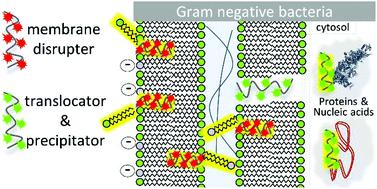当前位置:
X-MOL 学术
›
Biomater. Sci.
›
论文详情
Our official English website, www.x-mol.net, welcomes your feedback! (Note: you will need to create a separate account there.)
Combination of guanidinium and quaternary ammonium polymers with distinctive antimicrobial mechanisms achieving a synergistic antimicrobial effect.
Biomaterials Science ( IF 6.6 ) Pub Date : 2020-09-10 , DOI: 10.1039/d0bm00752h Jiayu Leong 1 , Chuan Yang , Jason Tan , Bing Qian Tan , Sherwin Hor , James L Hedrick , Yi Yan Yang
Biomaterials Science ( IF 6.6 ) Pub Date : 2020-09-10 , DOI: 10.1039/d0bm00752h Jiayu Leong 1 , Chuan Yang , Jason Tan , Bing Qian Tan , Sherwin Hor , James L Hedrick , Yi Yan Yang
Affiliation

|
The increasing emergence and spread of antimicrobial resistance are urgent and important global challenges today. The clinical pipeline is lacking in innovative drugs that avoid the development of drug resistance. Macromolecular antimicrobials kill bacteria and fungi through physical disruptions to the cell membrane, which is difficult for microbes to overcome. Recently, we reported antimicrobial polycarbonates that kill microbes via two different mechanisms. Polycarbonates functionalized with quaternary ammonium disrupted the lipid bilayer membrane of the microbes, while polycarbonates functionalized with guanidinium translocated the membrane and precipitated cytosolic components. We hypothesized that the combination of these two distinct mechanisms would result in a more than additive increase in antimicrobial efficacy. Block and random copolymers containing both cationic groups had similar minimum inhibitory concentrations (MICs) as the guanidinium homopolymer on 5 representatives of the ESKAPE pathogens. Interestingly, the random copolymer killed P. aeruginosa and A. baumannii more rapidly than the block copolymer and the guanidinium homopolymer with the same number of guanidinium groups. Like quaternary ammonium homopolymer, the copolymers killed the bacteria via a membrane-disruptive mechanism. Then, we simply mixed quaternary ammonium homopolymer and guanidinium homopolymer, and studied antimicrobial activity of the combination at various concentrations. Checkerboard assay results showed that the combination of the polymers, in general, achieved a synergistic or additive effect in inhibiting the growth of bacteria. At concentrations where it exibited a synergistic or additive effect in inhibiting bacterial growth, the combination killed the bacteria effectively (99%–99.9% killing efficiency) although the individual polymers at these concentrations did not exert bactericidal activity. Therefore, it is essential to have the two functional groups on separate molecules to provide synergism. This study provides a basic understanding of polymer design with different cationic groups.
中文翻译:

胍盐和季铵盐聚合物与独特的抗菌机制相结合,可实现协同抗菌效果。
抗菌素耐药性的不断出现和扩散是当今迫切而重要的全球挑战。创新药物缺乏避免药物耐药性发展的临床途径。大分子抗菌剂通过物理破坏细胞膜杀死细菌和真菌,这是微生物难以克服的。最近,我们报道的抗菌聚碳酸酯杀死微生物通过两种不同的机制。用季铵官能化的聚碳酸酯破坏了微生物的脂质双层膜,而用胍鎓官能化的聚碳酸酯使膜移位并沉淀了胞质成分。我们假设这两种不同机制的结合将导致抗菌功效的累加增加。含有两个阳离子基团的嵌段和无规共聚物在5种代表ESKAPE病原体上具有与胍鎓均聚物相似的最小抑菌浓度(MIC)。有趣的是,无规共聚物杀死了铜绿假单胞菌和鲍曼不动杆菌。比具有相同数量胍基的嵌段共聚物和胍均聚物更快。像季铵均聚物一样,这些共聚物通过以下方式杀死细菌:破坏膜的机制。然后,我们简单地将季铵均聚物和胍鎓均聚物混合,并研究了该组合在不同浓度下的抗菌活性。棋盘检测结果表明,聚合物的组合通常在抑制细菌生长方面达到了协同或累加作用。在抑制细菌生长具有协同或累加作用的浓度下,该组合有效杀死细菌(99%至99.9%的杀灭效率),尽管这些浓度下的单个聚合物均未发挥杀菌活性。因此,必不可少的是在单独的分子上具有两个官能团以提供协同作用。这项研究为具有不同阳离子基团的聚合物设计提供了基本的了解。
更新日期:2020-09-22
中文翻译:

胍盐和季铵盐聚合物与独特的抗菌机制相结合,可实现协同抗菌效果。
抗菌素耐药性的不断出现和扩散是当今迫切而重要的全球挑战。创新药物缺乏避免药物耐药性发展的临床途径。大分子抗菌剂通过物理破坏细胞膜杀死细菌和真菌,这是微生物难以克服的。最近,我们报道的抗菌聚碳酸酯杀死微生物通过两种不同的机制。用季铵官能化的聚碳酸酯破坏了微生物的脂质双层膜,而用胍鎓官能化的聚碳酸酯使膜移位并沉淀了胞质成分。我们假设这两种不同机制的结合将导致抗菌功效的累加增加。含有两个阳离子基团的嵌段和无规共聚物在5种代表ESKAPE病原体上具有与胍鎓均聚物相似的最小抑菌浓度(MIC)。有趣的是,无规共聚物杀死了铜绿假单胞菌和鲍曼不动杆菌。比具有相同数量胍基的嵌段共聚物和胍均聚物更快。像季铵均聚物一样,这些共聚物通过以下方式杀死细菌:破坏膜的机制。然后,我们简单地将季铵均聚物和胍鎓均聚物混合,并研究了该组合在不同浓度下的抗菌活性。棋盘检测结果表明,聚合物的组合通常在抑制细菌生长方面达到了协同或累加作用。在抑制细菌生长具有协同或累加作用的浓度下,该组合有效杀死细菌(99%至99.9%的杀灭效率),尽管这些浓度下的单个聚合物均未发挥杀菌活性。因此,必不可少的是在单独的分子上具有两个官能团以提供协同作用。这项研究为具有不同阳离子基团的聚合物设计提供了基本的了解。



























 京公网安备 11010802027423号
京公网安备 11010802027423号